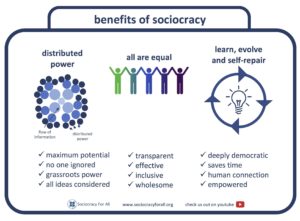THE CHALLENGE
Our vision is for organizations to be effective. Inclusive. Transparent. Everyone’s voice should be heard. The reality is power struggles. Endless meetings. Not enough output. Frustration.
Most people share the vision, but the reality of “everyone’s voice matters” is hard to put into practice. This might be familiar: ideally, meetings are the time when we get to hear each other. But then – why do they have to take so long, lead to so much frustration and way too often, too little gets done? The reality in most organizations consists of meetings where people who repeat themselves, while others roll their eyes. Plans that never happen, meetings that leave us feeling disconnected. That’s not what we signed up for. And it is not the way it has to be.
Why does a purpose-driven organization fall so short on how they do things themselves – what can be done? HOW do we make sure everyone’s voice matters?

We work with egalitarian organizations that often start out with one misconception: when all of us are decision-makers, things will be fair. Unfortunately, it is not that easy. More likely, when all of us are decision-makers, we will argue and nothing will happen. What’s going on?
All of us grew up (and are still immersed) in power-over systems, with all the -isms still going strong. Sexism, racism, classism, etc. Their impact is always in the room, and ignoring it won’t fix it. One practical implication of that is even if we want to create an open, just discussion, the old patterns are still very much with us. Some people make themselves heard – and others not so much. In order to overcome those patterns, we need some serious effort to counterbalance this. A simple tool we use and teach in sociocracy are rounds.
Everyone in the room gets a turn to speak, one by one. Not only does this support people in speaking (especially those who do not tend to speak up), but rounds also support listening. Are you familiar with a situation where someone else is speaking and on your mind, you are already preparing your counterargument, while you are just waiting for a good moment to interrupt them and jump in, proving them wrong? Rounds help break that pattern of competition and dominance. If you know that it will not be your turn until the round comes to you, you will sit back. And while you are sitting back, you will be much more likely to listen.
We cannot all be decision-makers at the same time for all decisions. If we are all decision-makers and try to get to consensus on a decision, then we are likely to burn out. There are two aspects of that. Consensus (we talk until we all agree) works well in homogeneous groups. But it is often not implemented as a process that is strong enough to hold dissent. To keep it simple, let’s shorten the difference between consensus and consent to a slogan. Consensus asks” do you agree?”. Consent asks: “do you object?” Many consensus-run groups use consensus in a way we describe consent, and it serves them well. Others do not have a formal process in place and they suffer from blocks and lack of forward-movement. If we widen the “range of tolerance” — the decisions we are willing to work with even though they are not our preference — we create more options for common ground. We can make decisions even in heterogeneous groups. Since everyone can object (on the basis of a reasoned objection), no one will be ignored. But we also get things done!

With these (and some more) tweaks, egalitarian organizations can be effective. In the long run, they will be even be more effective than autocratic organizations because everyone can tap into the innate desire to contribute and collaborate, creating more sustainable decisions and more buy-in from everyone. Balancing group needs and individual needs, organizations transition from a competitive paradigm into a collaborative mindset where we together create a win-win.
Is this already being done? Yes. Quite a lot. The biggest example is the children’s parliament in India where hundreds of thousands of children in thousands of teams (we call them circles) collaborate to improve their immediate environment, in layers of linked circles that go up to a national level.
 But also worker-cooperatives, communities, non-profits and for profits work with sociocracy, a model that was developed in the early 1980s in the Netherlands and has since spread in Europe, the Americas and India. Sociocracy is particularly helpful for multi-stakeholder organizations because it is strong at hearing many different views while supporting the members in moving forward with clarity and accountability.
But also worker-cooperatives, communities, non-profits and for profits work with sociocracy, a model that was developed in the early 1980s in the Netherlands and has since spread in Europe, the Americas and India. Sociocracy is particularly helpful for multi-stakeholder organizations because it is strong at hearing many different views while supporting the members in moving forward with clarity and accountability.
Learning sociocracy is very affordable and doable. You can learn sociocracy in small study groups in your own living room with a study group curriculum we developed. Videos lead you through a total of 6 sessions (of about 1.5h each), with exercises, lectures, handouts, session plans and enrichment content all prepared. All you need is a group, internet connection and the willingness to try something new. Most likely you will fall in love with it.





